| 1 | Long-nosed worm snake |
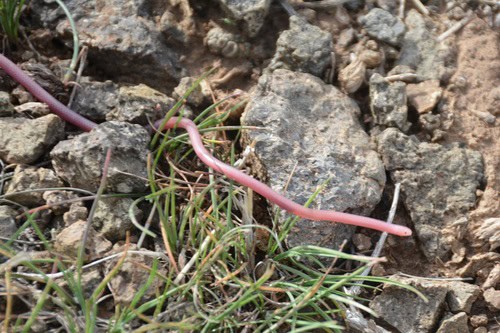
A harmless underground serpent of the Middle East and northeast Africa. You can find the long-nosed worm snake in dry, arid semi-deserts of Israel, Saudi Arabia, Egypt, Syria and many more.
Worldwide, there’s over 400 blind snake species, and this embodies virtually all their typical characteristics. Myriopholis macrorhyncha has small shrunken eyes, which have deteriorated due to 10s of millions of years of an underground lifestyle. They cannot distinguish shapes, only perceiving basic changes in light intensity. Myriopholis macrorhyncha is a tiny snake, reaching a maximum of just 31cm (recorded in Iran). They possess neither venom nor teeth, and have no ability to harm a human in any way.
Myriopholis macrorhyncha closely resembles a worm from a distance, but they have a vertebrae and their body is covered with tiny scales. Their one distinguishing feature is their pink colours, rather than the typical brown.
Long-nosed worm snakes are restricted in their prey, eating only creatures which share their underground habitats and are tiny enough for them to swallow, such as termites and termite larvae. This is an egg-laying species, typically in batches of 3. Myriopholis macrorhyncha occasionally ventures to the surface at twilight, poking their heads out of small cracks and holes.
| 2 | Brahminy blind snake |
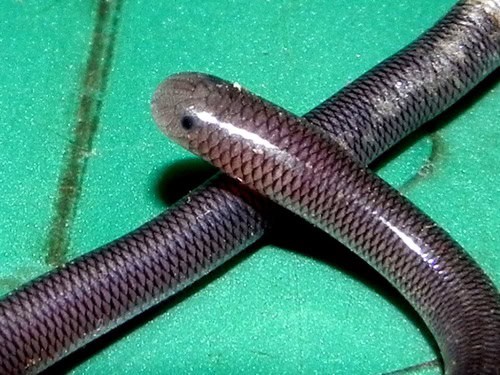
A snake which has achieved world domination. The Brahminy blind snake (Indotyphlops braminus) is the most successful invasive snake of all, easily beating the Burmese python which has conquered Florida’s everglades. It’s also the most common blind snake worldwide, and perhaps overall snake.
Originally, the flowerpot snake (as it’s also known) lived in Africa and Asia, though it’s hard to pinpoint the exact native range given how successfully it has spread. The reason is lurking in the soil of ornamental plants, shipped far and wide overseas. It’s precisely because of their soil burrowing tendencies that they’ve spread undetected. Indotyphlops braminus is now abundant in northern Australia, parts of Europe, Mexico and the southern US, especially Florida.
This is an extreme blind snake in several ways, as it reaches a maximum of 15cm, making it one of the smallest snakes worldwide. All known specimens have been female, as it reproduces asexually. Brahminy’s blind snakes possess typical features such as miniscule, shrivelled eyes, and a lack of fangs or venom. The eyes are covered with transparent scales (which sounds painful) and this species lacks virtually any patterns.
| 3 | Western blind snake |
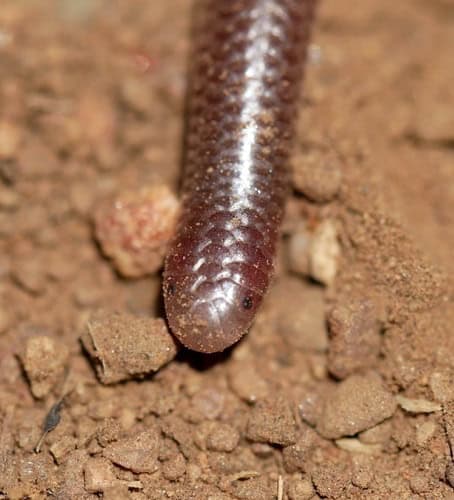
The most common blind snake in southern California, Arizona and far southern Nevada. The western threadsnake (Rena humilis) also plunges deep into Mexico, only disappearing around Mexico City. This species belongs to the same 10-member Rena genus as the Texas blind snake and rarely exceeds 30cm.
Rena humilis has no fangs, and no venom. Its eyes are shrivelled, and capable of perceiving only basic changes in light intensity. But Rena humilis isn’t completely feeble. It has the advantage of a thick skull, which aids its burrowing quest, a quest which never ends, for western threadsnakes are dependent on underground termites for their meals. They’re naturally averse to being exposed on the surface for too long, just as a human is naturally averse to standing outside in the rain naked, an automatic reaction.
Many burrowing snakes live in the upper soft layers of soil, but Rena humilis is known to reach as deep as 20 metres, in the southern Californian realms it calls home. Naturally, an important habitat requirement is loose enough soils to dig in. Despite reaching so deep underground, sightings of western threadsnakes are constant in the southwestern US, so it’s likely that this is quietly one of the most abundant snakes in California.
| 4 | Beak-nosed worm snake |
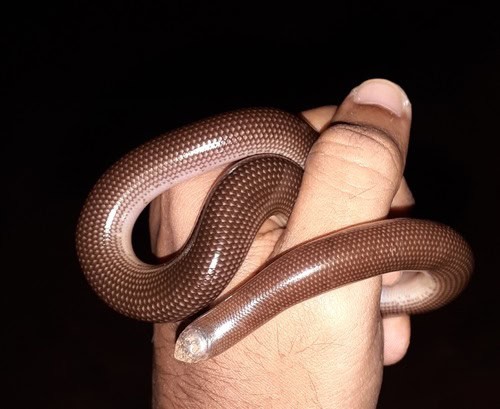
One of India’s most common blind snakes, particularly along the southwest coast. This is a near-eyeless snake that could be below your feet at any moment near Goa or Mumbai.
Unlike several massive blind snake groups, this species is isolated, as it’s the sole member of its Grypotyphlops genus. Up close, it has a chocolatey base of scales covered with many fine pale spots. The start and end of its body look so similar that uninformed Indian locals think it has two heads.
Grypotyphlops acutus is found at elevations of 10 to 700 metres, and also appears in suburbs of urban zones like Chennai city. Places you’ll find this blind snake include beneath leaf litter, rocks, boulders and dead trees. Rather than dusty arid lands, they prefer moist areas such as agricultural fields. People digging them up have noticed how Grypotyphlops acutus rapidly tries to rebury itself whenever unearthed. They even try to poke intruders with their sharp tail occasionally, making this blind snake slightly more aggressive than average. Their tail is also used for leverage when moving across the surface.
| 5 | Indochinese blind snake |
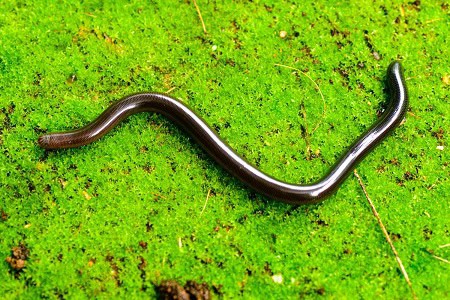
An exceptionally shiny blind snake, and a virtually patternless one, which is very dark brown lower on its body and slightly lighter around the head, making its tiny dots of eyes possible to see. Indochinese blind snakes (Argyrophis diardii) live mainly in Thailand, where they’re one of the largest blind snakes. They peak at 43cm and are relatively thick too. This species occupies various habitats, but always more moist ones, including grasslands, forests and agricultural fields.
Argyrophis diardii has the rare blind snake feature of laying live young, shared with Mueller’s blind snake, also found in Thailand. It’s relatively determined to survive, using three defensive methods: 1) stabbing with a sharp tail, 2) releasing a foul-smelling musk, and 3) wriggling furiously. All can be overcome if you hold your nerve.
Argyrophis diardii is difficult to find, but like most blind snakes, they usually come to the surface post heavy rains and in humid conditions. Their diet includes insect larvae and earthworms, and while sightings are few, they’re almost certainly eaten by larger snakes themselves.
| 6 | Giant African blind snake |
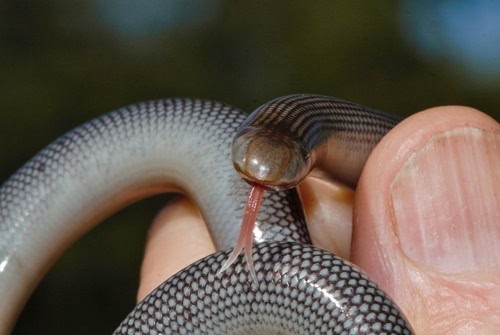
One of the most distinctive African blind snakes, firstly because of its jumbo size of up to 1 metre. This larger size allows you to spot their strangely shaped snout, with hard-looking scales designed to scoop through hard soils and allow them access to subterranean tunnel networks. Giant African blind snakes (Afrotyphlops mucruso) also have more patterns than their sightless kin. Some are dark with rapidly alternating white flecks while another group have olive patches spreading in a haphazard manner, like scales flaking off.
This species inhabits open savannahs and savannahs with forest patches. Afrotyphlops mucruso is as blind and fossorial as ever, yet their large size inevitably makes them more visible. Giant African blind snakes can live deep underground, and despite their slow, sluggish manner, they’re far from lazy – they’re active hunters which seek out termite dens before feasting enthusiastically. They also have unusually large egg totals of 12-40, and a maximum of 60.
Afrotyphlops mucruso ranges from 0 metres in coastal thickets, to high altitudes of 1600 metres. They range from southern Kenya through Tanzania and Mozambique to northeast South Africa. This species belongs to the 28 member Afrotyphlops genus.
| 7 | Big-scaled blind snake |
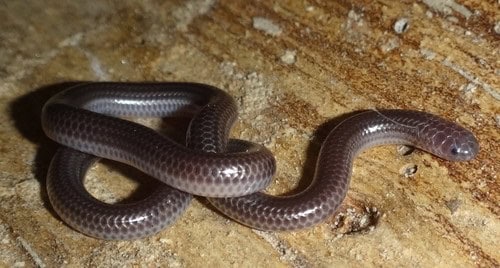
A blind snake of extreme northern South America, spreading from Colombia through Venezuela to Ecuador. Trilepida macrolepis is recognisable by its net-like patterns, which are pale coloured and divided into shapes like honeycomb. Its eyes are more visible than other blind snakes, though still mostly useless. Their round black eyes make them look like a cartoon character.
At an average of 30cm, the big-scaled blind snake is very challenging to find. Ripping up old decaying logs is your best bet, or digging through soil at the back of your garden.
This is a flexible blind snake in many ways. They appear in ancient forests, plantations and suburban gardens alike. They spend most of their lives underground, but also surface and hide in tree bark, even 2.5 metres above ground. They can also move during day or night. Trilepida macrolepis have a sharp tail for poking, but this causes a pinprick at best. Big-scaled blind snakes are preyed upon by local ophiophagous snakes like Clelia clelia.
| 8 | Prog-snouted blind snake |
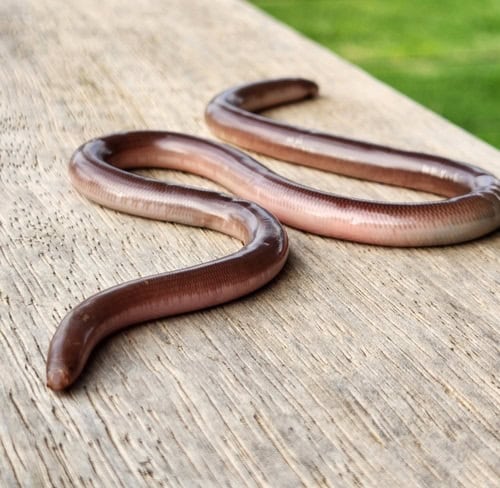
One of Australia’s most common blind snakes. The blackish blind snake is most common on the east coast near Sydney, while the prong-snouted blind snake (Anilios bituberculatus) reigns supreme slightly further west, particularly near Adelaide and its outskirts.
Anilios bituberculatus reaches a maximum of 45cm, and has a snout the shape of a shark’s. It has an enormous overbite, giving it the look of a bizarre elf, or like it has a huge nose. This species is well adapted to arid areas, and is regularly scooped out of termite’s nests, probably while attempting to eat the occupants.
Anilios bituberculatus has slightly more defence mechanisms than other blind snakes, with a vile smell it releases to force disgusted predators to leave the area. This blind snake is believed to be preyed on by owls and bandy-bandys, yet remains extremely widespread and common. They have the honour of inhabiting every Australian state, as their range broadly covers the southern centre of the country. Anilios bituberculatus feeds by raking swarming termites into its mouth, by extending and retracting its upper jaw.
| 9 | Long-tailed thread snake |
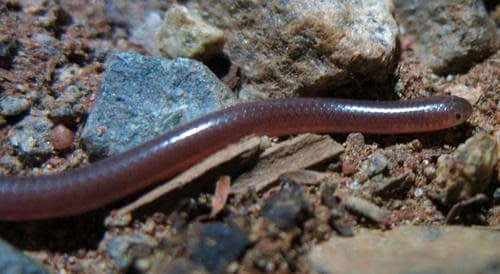
Part of the 24 member Myriopholis thread snake family, which live in Africa and the Middle East . The long-tailed thread snake is among the largest, yet still reaches a maximum of only 25.5cm.
This blind snake lives in northeast South Africa, Zimbabwe and Mozambique. While their pupils are visible, they’re little more than biro pen dots – if you bent down to examine its face, they wouldn’t even distinguish a vaguely humanoid blur, more likely they’d comprehend a slight dimness. They might smell you however, but even then, you’re not at risk. Myriopholis longicauda is like all other 400+ blind snakes in that it lacks venom or even teeth. Their response when cornered is an intense wriggling.
This species is believed to feed on termites and their eggs, and when found on the surface, are usually below rocks or twisting beds of roots. Savannah is their main home, but searching for one deliberately is extremely difficult. You’re more likely to find one purely by accident, as searching for the exact spot they poke their head up at night is a nightmare.
| 10 | Latin American blind snake |
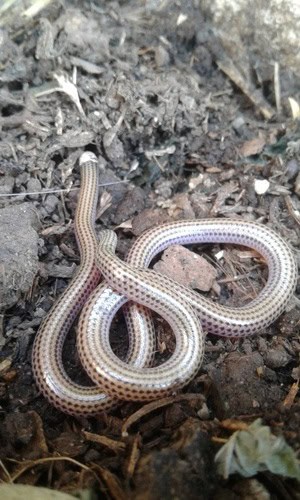
The blind snake lurks under the soils of the southern reaches of South America, meaning Argentina, Bolivia, and Paraguay. At a distance it looks generic, but up close, it’s more patterned than many of its brethren, with numerous subtle lines and spots. Its eyes are some of the least visible of any blind snake, and both head and tail feature a light scale that makes them difficult to tell apart. The only solution is identifying a sharp point on the tail.
The Latin American blind snake (Epictia albipuncta) reaches a confirmed maximum of 34.1cm. They’re kept alive by their burrowing lifestyle, yet still fall victim to other snakes.
In March 2013, scientists collected two painted lanceheads (Bothrops diporus), Argentina’s most common venomous snake, the one responsible for most bites. These were male and female, and each contained an Epictia albipuncta in its stomach. Still, if they moved around on the surface all day they’d probably go extinct. This is a completely weak and defenceless snake, yet extremely widespread in South America.
